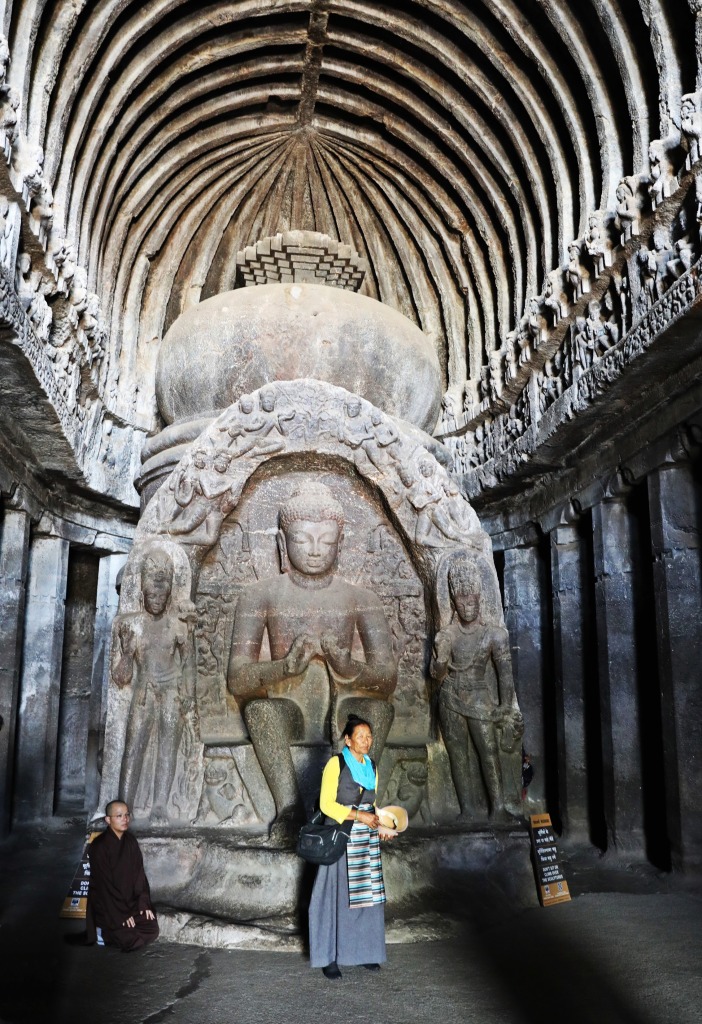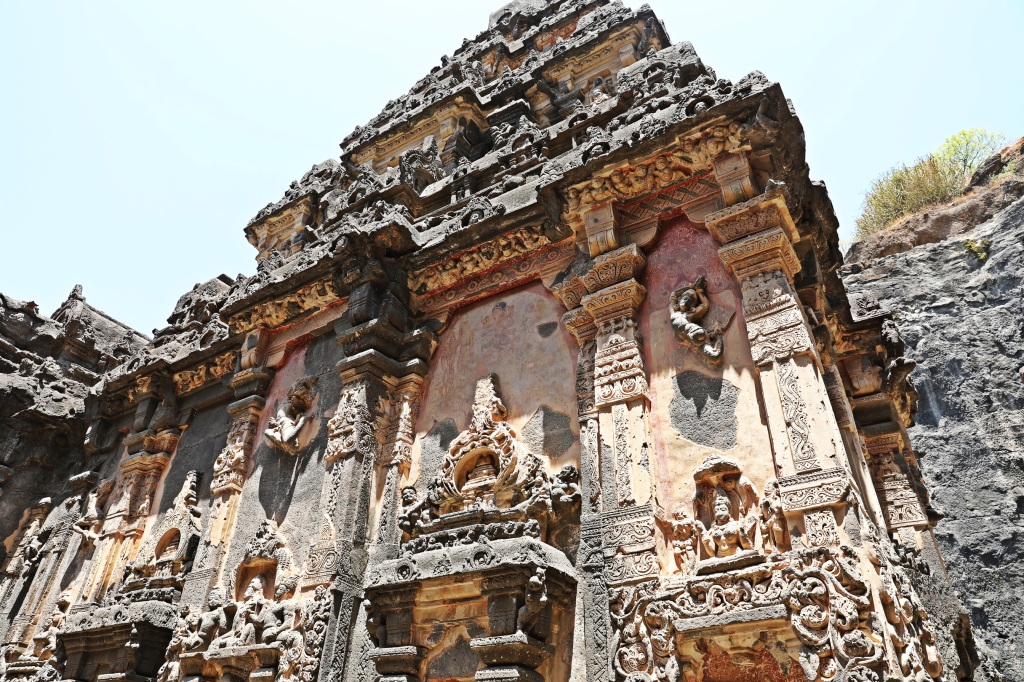What could you do with a crudely made hammer and chisel? I doubt many of us would take on the daunting task of carving a design into solid rock. As early as the 3rd century BC, masons and sculptors were creating massive temples by carving caves into solid basalt rock walls. These works of art are the rock-cut temples of Ajanta and Ellora.
The UNESCO World Heritage Site of Ajanta lies in a rocky cirque above a deep gorge. When we visited, it was the end of dry season, so the area was brown, dusty and hot. In 200 BC, Buddhists started chiseling out rock-cut temples from the basalt rock cliff. There are 27 caves in total, each the size of a small house. Most of the caves are square halls with a main large Buddha statue or stupa in an inner sanctum. The rooms are supported by large columns, many of which are decorated with detailed carvings. The walls have many different carvings of Buddha, Bodhisattvas or lotus flowers, animals or consorts and kings. As you look at the pictures below, remember that these are all carved from one rock, they are not natural caves.









In addition to the incredible sculptures, the highlight of the Ajanta caves are the magnificent frescoes on the walls, columns and ceilings. Many of the details on these colourful paintings can still be seen. The paintings include depictions of Buddha’s life, rebirth and his teachings. Others are of his consorts and Bodhisattvas.









Three caves were different in their design. They have a long nave, cathedral ceilings and a large stupa or Buddha statue. They are breathtaking. Early Buddhist caves did not have Buddha statues as he did not wish to be immortalized as an idol. In the 1st century AD however, Buddhist statues started appearing in temples and have been a part of temples ever since. These temples have a pathway around the stupa so that worshipers could circumambulate clockwise around the stupa, called a kora, as is Buddhist custom.
Some of the caves were two stories with an outer staircase between floors. Other caves have sculpted verandas or elaborately decorated facades. There was a friendly troupe of Grey Langur monkeys hanging around the caves when we were there. These ones seemed to love to pose for pictures.







Historians believe that the Ajanta caves are a part of a monastery. Some caves have small, plain rooms along the side. These were monk’s cells or bedrooms in the monastery. One cave had not been completed so we were able to see how the sculptors chiseled long pathways, leaving sections of rock for other projects. As we walked through these temples, we had to keep reminding ourselves that all of this work was carved out of a solid rock. The caves were dark inside with only a little modern lighting to display the sculptures. I couldn’t imagine being the sculptors and painters, having to make this incredible art by the light from a fire.



As Ajanta started to become less important, a new rock-cut site emerged. A hundred kilometers away on the side of a basalt cliff are 34 rock-cut temples. The UNESCEO World Heritage Site of Ellora has rock-cut temples from 600 -1000 AD. There are three separate areas with caves from Buddhists, Hindus and Jains.
The Buddhist temples are similar, but more sophisticated, than the temples of Ajanta. There are a few two and three storied temples with more elaborate carvings and designs. We met a group of Tibetan Buddhists and a separate group of Asian nuns at the site. The Tibetan women must have been very hot in their layers of traditional heavy clothing.







Of the 17 Hindu caves, Kailasa Temple, is the most impressive. It was carved top down from one piece of rock. There is a three-story temple, a two story gopuram (gate) and many shrines. There are internal stairs, doorways and windows in these buildings. The large courtyard has two life sized elephants and two tall columns.



All the walls on the buildings and outer cave are covered in gorgeous carvings. Some are large elephants, and other are small delicate deities or flowers. Many carvings are of Shiva, Parvati or Nandi and depict stories from their lives. Inside the temple is a Shiva shrine surrounded by lavishly carved columns. The entire cave is larger than Greece’s Parthenon, quite a feat that took 150 years to complete. As you look at the pictures below, remember that these are all carved from one rock.









The remaining Hindu caves are also impressive. There are three storied caves with internal staircases, huge columns and large verandas. Some have incredibly elaborate balconies and facades. The insides have many carvings of Hindu Gods, especially Shiva and his family and consorts.










One km away is a group of five Jain temples. These caves have two sets of inter-connected rooms and secret passages. The caves are smaller than the Hindu or Buddhist caves, but the details in these carvings are more elaborate. In one room there are frescoes that are still in relatively good condition. Jain is an ancient religion that began around the time of Buddhism. One of its main principles is minimalism. Priests and teachers often go without clothes, so many of the paintings and sculptures, of course, are nudes.










Both of these sites are not far from the large city of Aurangabad. While we were having dinner one night, a wedding procession passed by on the street. There were drummers and horns, a long line of ladies and then the bride and groom on a horse carriage. It was a lovely surprise.


Coming up next: Mumbai
For extra pics from this trip go to Gallery/Western India. For extra pictures from other blogs go to Gallery at monkeystale.ca
To read about more of our adventures go to Destinations.
If you like what you read, please comment or share it using the links below.
These cave temples are just amazing. We were blown away by the Dambulla cave temples in Sri Lanka for their magnificent colours and Buddha sculptures. These seem to be far more elaborate in the level of fine carving detail.
LikeLiked by 1 person
Yes these caves were spectacular. We were glad we visited Dambulla first as these are far more impressive. Ajanta is one of the best sites we’ve seen on the whole trip. The details, the colours the size and the number of caves all made the site so incredible.
LikeLiked by 1 person
Never made it here! 🙂 It’s been on our lost for a while. You might like Khajuraho in Madhya Pradesh. The temples are stunning.
LikeLiked by 1 person
We had to miss Khajuraho due to train and bus problems. It was one place that we still wish we had seen.
LikeLiked by 1 person
Even considering they were done over many lifetimes, the carving is amazing. It is hard to imagine anyone in this day and age taking on a project that would likely take hundreds of years to complete. And one wonders how much of what we create today will remain in a thousand years.
LikeLiked by 1 person
Yes we were thinking that exactly as we explored them.
LikeLike